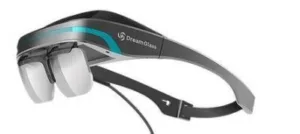DreamWorld USA Inc. (Millbrae, CA) was founded in Silicon Valley during 2016 by a team of AR enthusiasts that were highly experienced in optics and computer vision. In 2018 the company produced and delivered thousands of units of a Gen 1 product called the Dream Glass Air headset. The latest news is that the company has now designed and brought into early production an advanced headset product called the Dream Glass 4K.

The company describes the Dream Glass 4K as a “portable and private plug and play augmented reality glass” compatible with a wide range of devices.
The Dream Glass 4K is composed of two main parts. The first is a control box with 10 interface buttons that contains a battery and a computer. The second is the glasses themselves, which connects to the control box via a cable. The optics in the glasses are such that the image is projected downward and then reflected directly into the user’s eyes using a semi-reflective coating on a set of angled lenses. In this optical configuration, the user can look through the virtual imagery and see the external world. An alternate configuration is to clip a dark shade over the front of the lenses. The shade, available as an option, serves to block out the external world thus providing the user with a virtual reality experience.
Two version of the headset product are available. The Dream Glass 4K and the Dream Glass 4K Plus. The Plus model has additional features.
A slick if somewhat uninformative video illustrating and demonstrating the Dream Glass 4K headset is appended to the end of this article. The figure below is a photograph of the Dream Glass 4K headset and the control box.
The Dream Glass 4K headset and the control box.
While wearing a Dream Glass 4K headset, only the user can see the virtual imagery. By this means, the user has total privacy at all times. At the same time, since the Dream Glass 4K headset allows the user to see the outside world, the user is not isolated as is the case with conventional virtual reality headsets.
The Dream Glass 4K headset was designed to meet four top level goals. The first was to assure that consumers would be able to access a wide range of content. This was accomplished by designing the Dream Glass 4K headset to be compatible across the range of already adopted entertainment platforms including:
- Android and iPhone smartphones.
- Android and iPad tablets.
- Mac and PC desktops and laptops.
- Consoles including Sony PS4/PS5, Nintendo Switch and Microsoft Xbox.
- Streaming boxes.
- DJI drones.
The second goal was for the headset to offer a wide range of connection modes. This too was accomplished. The headset can connect by way of HDMI, USB, WiFi, Bluetooth and Hotspot. The third was for the headset to operate in a Plug and Play mode. It does so. The final goal was for the Dream Glass 4K headset to sell at a consumer friendly price. Since models are priced between $599 and $799, the company can rightfully claim to have met this last goal too.
Other features and specifications of the Dream Glass 4K Plus headset include the following:
- Field of view 90 degrees.
- 200 inch image size at 3 meters. Aspect ratio 18:9.
- Operation can be in either 2D or 3D mode. In 3D mode, can accept either side by side or top / bottom formats.
- 4K resolution. 1080p per eye (3840×1080 total).
- 868 ppi.
- A 10 layer optical coating on the lens elements reduces glare and potentially harmful blue light – without, it is claimed, any compromise in image quality.
- Weight 185 g without the cable.
- A 8000 mAh lithium ion battery can power continuous play for about 5 hours.
- 5G compatibility.
- Eye relief distance is sufficient to allow users to wear glasses while wearing the headset.
- CPU: 1.8 GHz quad core AI chip.
- GPU: Mali-T864.
- 64 GB storage.
- 4 GB memory.
- Two speakers (connection with either Bluetooth or 3.5 mm jack).
- 3 DOF head tracking.
- 1000 Hz high speed tracking.
- Refresh rate of 60 Hz.
- Front facing camera.
- External sensor port: USB 3.0 port on headset (can be used for hand gesture, RGB camera, IR camera and etc.).
- A Unity SDK is available.
- Packaged in a zip up hard travel case.
Initial funding for the Dream Glass headset was obtained by way of a successful Indiegogo campaign conducted in August 2020. At that time, 929 backers pledged $470,741. The company reports that this was the most funded project of augmented reality glasses in crowdfunding history. Since receiving these initial funds, the company successfully fulfilled all reward commitments. At this time, DreamWorld is conducting an InDemand campaign to bring the Dream Glass 4K product into full production. The campaign can be found here. At the time this article is written, $547,023 has been raised from 1,042 backers.
It is the company’s stated intention to start shipping shortly after a successful conclusion to the InDemand campaign. So confident is the company of meeting this schedule that they have stated in writing that “if we cannot ship Dream Glass 4K within 3 months after the campaign ends, we will provide a full refund, no question asked.” -Arthur Berman

